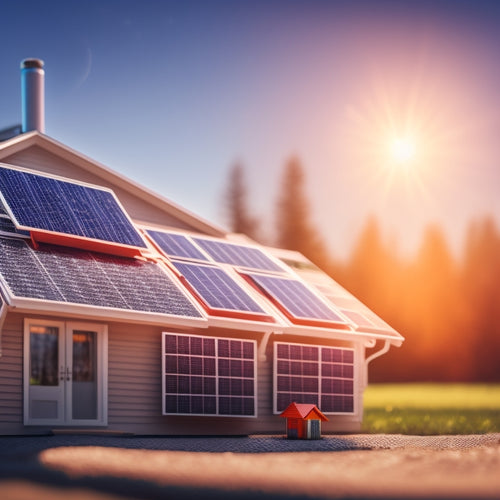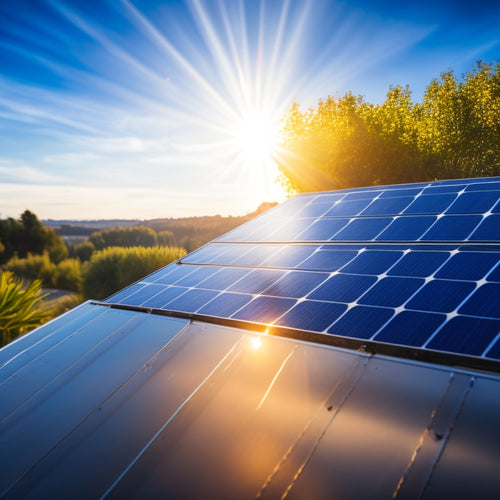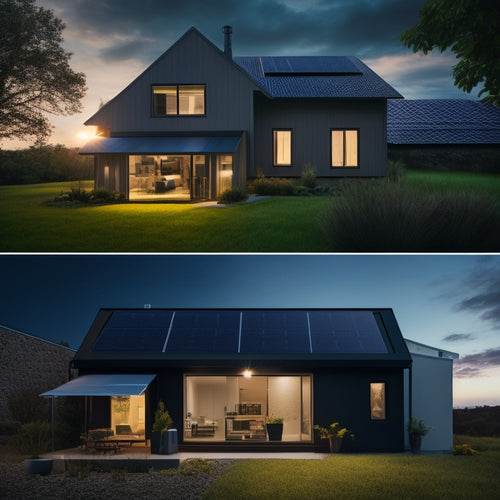
DC AC Inverters: A Game-Changer in Renewable Energy
Share
DC AC inverters are a breakthrough in renewable energy by enhancing efficiency and driving down costs. By optimizing energy conversion, these devices can greatly increase your energy yield, helping you save on bills while promoting sustainability. Their advanced features, like load balancing and real-time performance analytics, guarantee that every drop of energy is employed effectively. Selecting the right inverter, based on power ratings and compatibility, keeps your system efficient and reliable. As you investigate this technology further, you'll reveal even more understandings into its revolutionary effect on energy management.
At a Glance
- DC AC inverters enhance energy conversion efficiency, maximizing output and reducing energy waste in renewable energy systems.
- Advanced features like load balancing and system monitoring improve overall performance and prolong inverter lifespan.
- Investing in DC AC inverters leads to significant long-term cost savings and reduced reliance on grid electricity.
- Different inverter types cater to various needs, ensuring optimal performance for residential, commercial, and utility-scale applications.
- Proper sizing and compatibility with battery systems ensure efficient energy management and scalability for future energy demands.
Efficiency in Energy Conversion
When you assess the efficiency of DC to AC inverters, you'll notice that improving the conversion rate is vital for maximizing energy output.
Advanced features like load balancing and surge protection can further enhance system performance.
Optimizing system performance not only enhances the inverter's functionality but also contributes to overall sustainability in renewable energy applications.
Conversion Rate Improvement
A significant improvement in conversion rates can drastically amplify the efficiency of energy systems using DC AC inverters. By optimizing conversion technology, you can expect significant gains in efficiency metrics, allowing you to utilize more energy from renewable sources.
Different inverter types offer unique benefits, but focusing on high-performance options helps maximize energy storage capabilities and guarantees seamless grid integration.
When considering installation, pay close attention to load management strategies that can directly impact the overall performance of your system. Properly managing loads not only increases conversion rates but also extends the inverter lifespan, allowing for a more sustainable energy solution.
Additionally, evaluating the environmental impact of your inverter choices is essential; choosing high-efficiency models minimizes waste and improves the eco-friendliness of your energy production.
As you investigate advancements in DC AC inverters, keep in mind that improved conversion rates lead to greater energy independence and freedom from traditional power sources.
System Performance Optimization
Optimizing system performance in energy conversion is crucial for maximizing the efficiency of DC AC inverters. By focusing on critical elements like system monitoring and performance analytics, you can identify areas for improvement. Regular inverter upgrades guarantee grid compatibility, allowing your systems to adapt to changing energy demands.
Implementing best installation practices and adhering to maintenance requirements will further enhance performance. Load management techniques play a fundamental role in balancing energy supply and demand, guaranteeing that your renewable integration is seamless.
Here's a quick overview of key factors influencing inverter performance:
| Factor | Importance | Action Required |
|---|---|---|
| System Monitoring | Tracks real-time performance | Invest in monitoring tools |
| Performance Analytics | Identifies inefficiencies | Regularly analyze data |
| Inverter Upgrades | Guarantees compatibility with grid | Schedule periodic updates |
Cost Savings Over Time
Investing in DC AC inverters not only reduces your energy bills but also enhances your financial returns over time. By optimizing energy conversion, these systems maximize efficiency, leading to significant savings that compound annually.
In addition, the integration of solar energy systems, including these inverters, supports a shift towards a more sustainable energy future, reducing reliance on fossil fuels and lowering greenhouse gas emissions, contributing to climate change mitigation efforts.
As you investigate long-term investment benefits, you'll find that the initial costs are often outweighed by the ongoing financial advantages.
Reduced Energy Bills
Leveraging the power of DC AC inverters can considerably reduce your energy bills over time. By converting direct current from renewable sources into alternating current for home use, these devices optimize energy management, ensuring that you're tapping into every bit of power generated. This efficiency translates directly to financial savings, as you're less reliant on grid electricity, which often comes with escalating costs.
When you seize the potential of DC AC inverters, you're not just cutting down on expenses; you're also gaining greater control over your energy consumption. With real-time monitoring capabilities, you can identify energy usage patterns, allowing for smarter decisions that further lower your bills.
Imagine the freedom of producing your own energy and seeing your monthly expenses dwindle, all while contributing to a more sustainable environment.
Moreover, the integration of these inverters with battery storage systems enhances your energy independence, enabling you to make use of stored energy during peak pricing hours. This strategic approach to energy management allows you to break free from traditional energy costs, paving the path for a financially savvy and eco-conscious lifestyle.
Long-Term Investment Benefits
When considering the long-term investment benefits of DC AC inverters, it's clear that these devices offer substantial cost savings over time. By leveraging technology advancements, you can effectively improve your renewable energy systems, reducing reliance on grid power and minimizing energy bills. This shift not only enhances your ROI analysis but also aligns with current market trends favoring sustainable solutions.
Moreover, tax incentives associated with renewable energy investments can further strengthen your financial strategy. These incentives can offset initial capital expenditures, making financing options more accessible and appealing.
As you evaluate your investment strategies, consider the environmental impact of adopting DC AC inverters; they contribute to a cleaner, more sustainable future.
Additionally, keep an eye on policy implications that could affect the renewable energy environment. As regulations evolve, your proactive approach will guarantee you remain ahead of the curve, maximizing your returns while promoting sustainability.
Ultimately, investing in DC AC inverters isn't just about immediate savings; it's about securing long-term benefits that connect with your desire for freedom and independence in energy consumption.
Key Technical Specifications
When evaluating DC AC inverters, understanding efficiency ratings is vital for optimizing performance in renewable energy systems.
Selecting the right inverter can greatly enhance the overall system efficiency, especially when paired with high-capacity solar arrays and sturdy battery banks for maximum energy output.
You'll want to assess the power output options available, as they directly influence how well the inverter meets your energy needs.
Efficiency Ratings Explained
How do efficiency ratings impact the performance of DC AC inverters in renewable energy systems? Simply put, these ratings directly determine how effectively an inverter converts DC energy from sources like solar panels into usable AC power.
Higher efficiency means less energy wasted, which is vital for maximizing the benefits of your energy storage systems.
When you evaluate inverter technologies, you'll often come across efficiency figures expressed as a percentage. A rating of 95% means that 95% of the input DC energy is converted into AC power, while 5% is lost.
The efficiency isn't static; it varies with load conditions and operating temperatures, so consider the real-world performance in diverse environments.
Understanding these efficiency ratings allows you to choose an inverter that not only meets your energy needs but also aligns with your commitment to sustainable living.
By selecting high-efficiency models, you can guarantee reduced energy costs and lower carbon footprints.
This precision in inverter selection can enable you to maximize the potential of your renewable energy investments, giving you the freedom to utilize energy in a more effective and environmentally friendly way.
Power Output Options
Understanding power output options is essential for optimizing the performance of DC AC inverters in renewable energy systems. Different inverter types, including string inverters, microinverters, and central inverters, offer distinct power output capabilities customized to specific applications.
String inverters typically handle larger systems, providing high efficiency and scalability. They convert the collective output of multiple solar panels, making them ideal for residential and commercial setups.
Microinverters, on the other hand, work on a per-panel basis, allowing for maximum power output from each individual panel. This is particularly advantageous in installations where shading or orientation varies.
Central inverters cater to utility-scale projects, generating substantial power output while maintaining cost-effectiveness. With their sturdy designs, they can manage high voltage and current levels, ensuring seamless integration with grid systems.
When selecting an inverter, consider the desired power output and the specific requirements of your renewable energy system.
Selecting Based on Power Rating
When selecting an inverter, understanding power ratings is vital for optimizing performance.
You'll need to match the inverter capacity with your system's energy demands to guarantee efficient operation. This alignment not only enhances energy conversion but also prolongs the lifespan of your equipment.
Additionally, evaluating features such as battery type and compatibility can further improve system efficiency and reliability.
Properly evaluating these factors is fundamental for maximizing the benefits of your solar energy system.
Understanding Power Ratings
Power ratings play a crucial role in selecting the right DC AC inverter for your renewable energy system. Understanding the different power rating types—such as continuous, surge, and peak ratings—can greatly impact your system's efficiency and reliability.
Continuous power rating indicates the maximum load an inverter can handle over an extended period, while surge ratings reflect its ability to manage short bursts of higher demand.
When evaluating inverter specifications, you need to take into account the energy requirements of your appliances and the overall capacity of your power generation system. A well-matched inverter guarantees ideal performance and longevity, preventing overload situations that could damage your investment.
Moreover, analyzing power ratings enables you to make informed decisions about scalability. If you plan to expand your renewable energy system in the future, selecting an inverter with a higher power rating can provide the flexibility you need.
In essence, understanding power ratings equips you to utilize the full potential of your renewable energy setup, granting you greater freedom in managing your energy needs. Choose wisely, and you'll enhance the performance of your system while improving your energy independence.
Matching Inverter Capacity
Selecting the right inverter capacity involves carefully matching your system's power requirements with the inverter's specifications. This process, often referred to as inverter sizing, is essential for ensuring load compatibility and maximizing the efficiency of your renewable energy system. Here's a quick reference to help you understand how to select the appropriate inverter capacity:
| Inverter Type | Power Rating (kW) | Best Use Case |
|---|---|---|
| Grid-Tied | 3-5 | Residential solar systems |
| Off-Grid | 1-3 | Remote cabins |
| Hybrid | 5-10 | Combined solar and storage |
| Microinverter | 0.3-1 | Small-scale installations |
| Central Inverter | 10-100 | Large solar farms |
When you assess your energy consumption and production, consider peak loads, continuous loads, and future expansion possibilities. You don't want to under or oversize your inverter, as both can lead to inefficiencies. By aligning your inverter's capacity with your specific energy needs, you enable your renewable energy system to perform at its best, offering you the freedom to utilize the power of nature effectively.
Higher Reliability in Performance
When you consider the performance of DC AC inverters, enhanced energy conversion efficiency stands out as a critical factor.
By maximizing the conversion of direct current to alternating current, you can notably reduce energy losses and improve overall system reliability.
This efficiency not only elevates performance but also extends the lifespan of your renewable energy setup.
Enhanced Energy Conversion Efficiency
While the integration of DC AC inverters in renewable energy systems greatly increases energy conversion efficiency, it also enhances overall reliability in performance. You'll find that these inverters are designed to maximize solar integration, ensuring that every watt generated is effectively employed. This results in reduced energy losses during the conversion process, which is vital for improving your renewable energy output.
Moreover, the latest advancements in inverter technology promote inverter longevity, reducing the frequency of maintenance and replacements. With enhanced thermal management and sturdy components, these inverters can withstand varying environmental conditions, ensuring consistent performance over time. This reliability translates into a stable energy supply, enabling you to leverage renewable resources without worrying about equipment failure.
Additionally, the intelligent algorithms embedded in modern DC AC inverters adapt to real-time conditions, allowing for best energy conversion under diverse scenarios. You'll benefit from a system that not only meets your energy needs but also contributes to a more sustainable future.
In embracing these innovative solutions, you're not just improving efficiency; you're gaining a dependable partner in your renewable energy expedition.
Frequently Asked Questions
What Is the Lifespan of a Typical DC AC Inverter?
A typical DC to AC inverter lasts around 5 to 15 years, depending on inverter efficiency and advancements in inverter technology. Regular maintenance and ideal conditions can greatly extend its operational lifespan, ensuring reliable energy conversion.
Can DC AC Inverters Work During Power Outages?
You might think inverters can't function during outages, but they can! With proper setup, they restore power efficiently, allowing for critical loads to run even when the grid fails, enhancing your energy independence and resilience.
How Do Environmental Factors Affect Inverter Performance?
Environmental factors greatly impact inverter performance. Temperature affects efficiency, with extreme heat or cold reducing output. Humidity can lead to corrosion, affecting components. You'll want to monitor these conditions for ideal inverter functionality and longevity.
Are There Maintenance Requirements for DC AC Inverters?
Think of your inverter as a garden; it needs regular cleaning and efficiency monitoring to thrive. Neglecting maintenance can lead to decreased performance, so stay proactive to guarantee it produces energy effectively and efficiently.
What Types of Batteries Are Compatible With DC AC Inverters?
You'll find that lithium batteries and lead acid batteries are commonly compatible with DC AC inverters. Each type offers unique advantages, so consider your energy needs and preferences when selecting the best option for your system.
Explore More
In a world where energy demands are rising, embracing DC-AC inverters could revolutionize your approach to renewable energy. Imagine utilizing the power of the sun or wind with unmatched efficiency and reliability. Visualize your energy costs dwindling over time while your system outperforms expectations. But wait—what if you could select the perfect inverter customized to your needs? The future of energy conversion is here, and it's time to take the leap into a more sustainable tomorrow.
Related Posts
-

A Beginner's Guide to Navigating the Solar Investment Tax Credit
You're eligible to claim a significant Solar Investment Tax Credit (ITC) of 30% of total installation costs, but mane...
-

How Efficient Are Thin Film Solar Cells
Thin film solar cells provide an innovative approach to energy generation, boasting efficiency rates generally betwee...
-

Cost of Home Solar Battery
You're looking to invest in a home solar battery to reduce your grid reliance, but you're curious about the cost. The...


